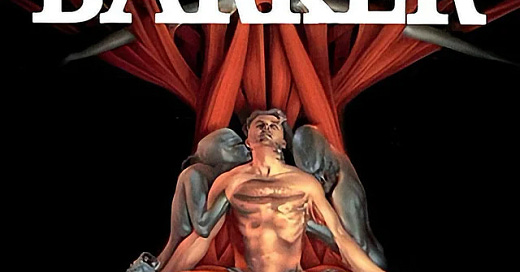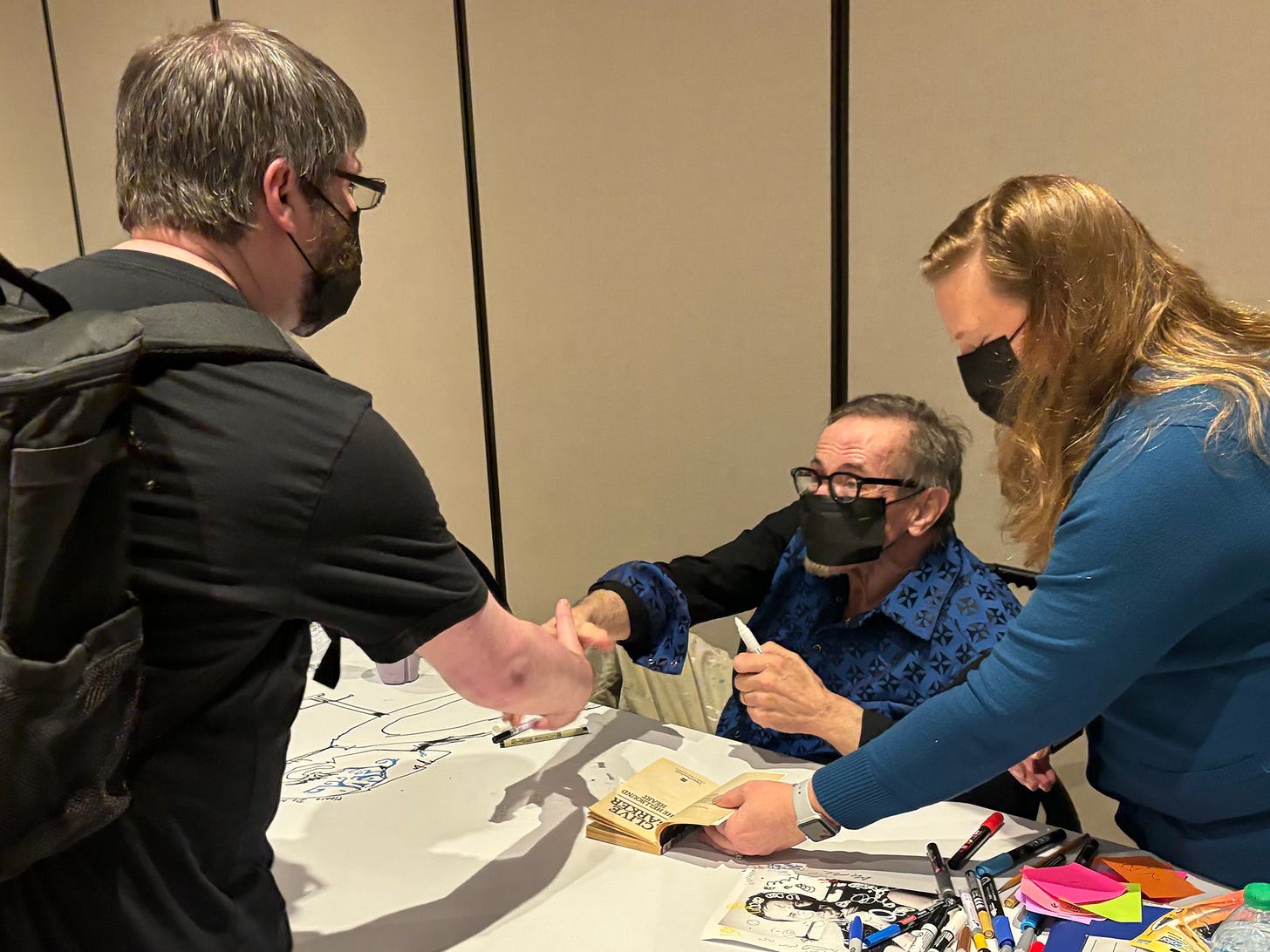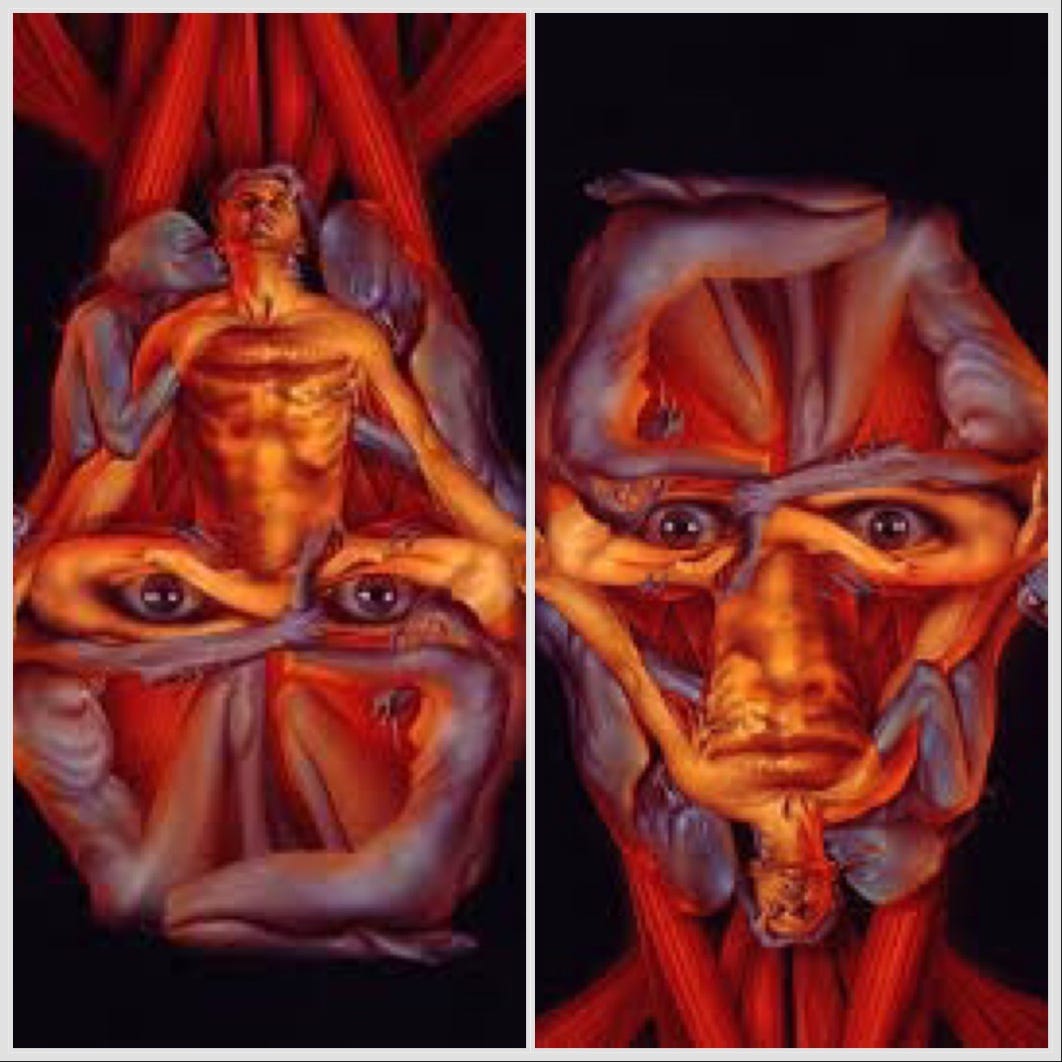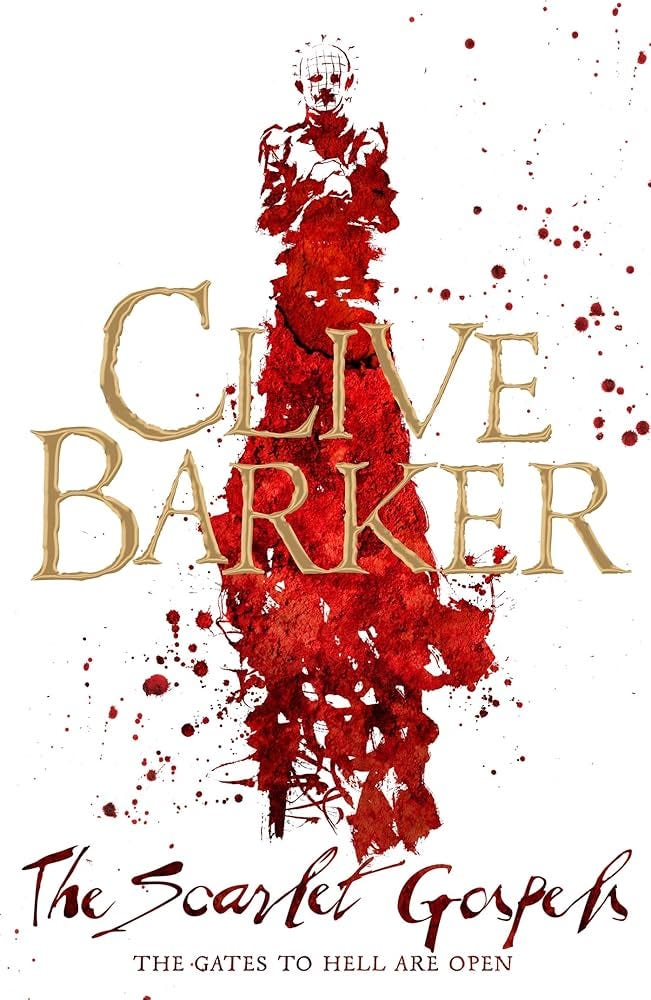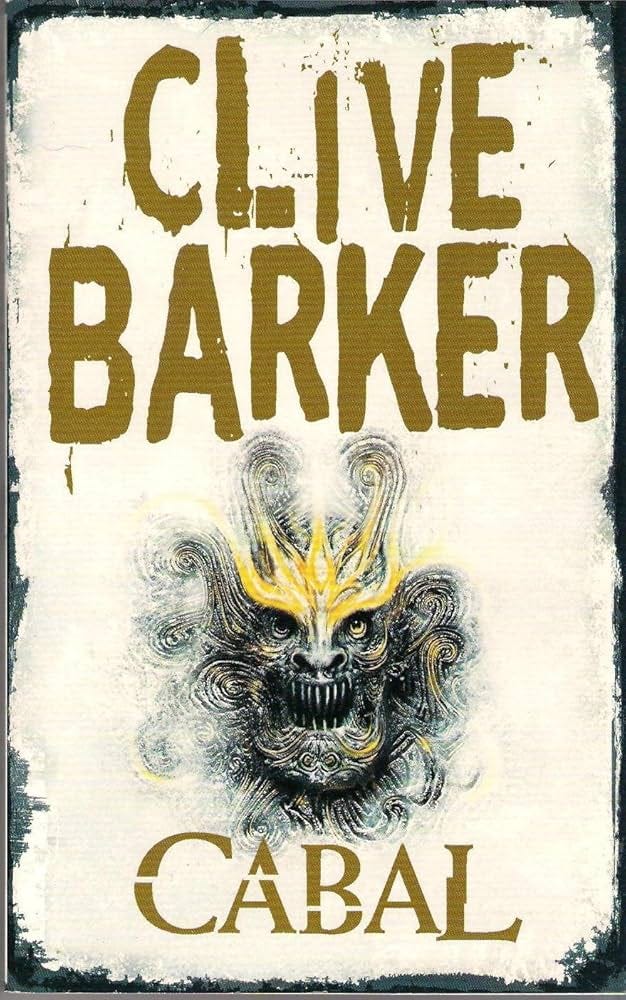The Great Clive Barker (Re)Read of 2024 Part 1
Going through the oeuvre of the master of the macabre
“I’ve seen the future of horror, and its name is Clive Barker.”
If you’ve ever read a book written by Clive Barker or watched a trailer for a movie directed by Clive Barker, then you have almost certainly seen the above quote from Stephen King. King is easily the most well known horror author of the second half of the twentieth century, and you could honestly make a case for him being the most famous horror author of all time. When he speaks, horror fans listen. King crowning someone as the future of the entire horror genre is certainly going draw some attention. As far as I’m concerned, King was spot on with his assessment of Barker.
While his quote (which came after reading Barker’s first Books of Blood anthology of short stories) gives the indication that these two writers are from two different generations, I consider them to be contemporaries. King’s first novel (Carrie) was published in 1974, and his first short story collection (Night Shift) was published in 1978. Meanwhile, Barker’s first novel (The Damnation Game) was published in 1985, and his first short story collection (the first volume of Books of Blood) was published in 1984. Both have put out numerous books, short stories, movies, etc. in the decades since.
Because I have always viewed them as peers and contemporaries, I also look at them as filling different niches in the horror community. King has always felt to me as the horror author most appealing to “normies.” His work is as mainstream as it gets in the horror genre. Virtually every person you know has heard of King, read one of his books, or seen a movie adapted from his writings. Barker’s work has typically had far less mainstream appeal. His stories are more subversive. He tackles subjects and themes that are frequently viewed as taboo and dripping with an eroticism that is rarely seen in horror. That’s what has made me such a big fan of his work.
As I briefly alluded to in last week’s post, I had the privilege of meeting Mr. Barker last month. I was obviously pretty stoked to meet someone I view as a living legend. I had done a reread of one of his books prior to meeting him, and I decided to tackle some of his other works after meeting him. That eventually snowballed into me reading or rereading as much of his oeuvre as possible. So began The Great Clive Barker (Re)Read of 2024. I decided it would be fun to track my progress here and give periodic updates on which books I’ve read and what I thought of them in the order that I’m reading them.
The Hellbound Heart (1986)
The Hellbound Heart is the first Clive Barker story that I ever read. More than that, it’s the first bit of Clive Barker media that I had ever interacted with overall. I got my copy from Half Price Books when I was in high school, and it made me an instant fan of Barker’s work. I know the saying is you should never judge a book by its cover, but the cover is the main reason I picked it up in the first place. As if the image by artist Kirk Reinert wasn’t cool enough as it is depicting a man being tortured (pleasured?) by demons, it can be rotated 180 degrees to become a gross skinless head and face.
It just so happens that this cool artistic design also illustrates an important plot point in the story itself. If you’re unfamiliar with this novella, it tells the story of a real piece of shit named Frank who fancies himself a hedonist on the search for the greatest pleasures a human can experience. That leads him to obtaining a strange puzzle box that he is told will summon demonic and/or angelic entities called Cenobites that will show him experiences in pleasure and pain beyond human comprehension if he is able to effectively solve said puzzle box. You’ll never believe this, but things do not go as well as Frank had hoped. If all of this sounds strangely familiar, it is because this story was adapted into the film Hellraiser in 1987 with Barker himself both writing and directing it.
As shocking as this might seem, I actually read this book before seeing Hellraiser. I never had much interest in the movie. I just knew there was a character named Pinhead in it and little else. The novella instantly became one of my favorite books of all time, and I watched the movie not long after. After loving the movie almost as much as the book, I was converted into a Clive Barker fan for life. I’ve read this novella many times, and it never loses any of its luster.
I wanted to briefly touch on the Cenobites themselves and how Barker describes them. Far from being generic demons that we’ve seen hundreds of times before in various books, movies, comics, and video games, these beings are truly unique both in appearance and nature. They are less cartoonishly evil entities and more a force of nature serving a purpose beyond our understanding. Here is how Barker describes the four Cenobites that appear before Frank at the beginning of the book.
Why then was he so distressed to set eyes upon them? Was it the scars that covered every inch of their bodies, the flesh cosmetically punctured and sliced and infibulated, then dusted down with ash? Was it the smell of vanilla they brought with them, the sweetness of which did little to disguise the stench beneath? Or was it that as the light grew, and he scanned them more closely, he saw nothing of joy, or even humanity, in their maimed faces: only desperation, and an appetite that made his bowels ache to be voided.
He then begins describing them individually.
“What city is this?” One of the four enquired; Frank had difficulty guessing the speaker’s gender with any certainty. Its clothes, some of which were sewn to and through its skin, hid its private parts, and there was nothing in the dregs of its voice, or in its willfully disfigured features that offered the least clue. When it spoke, the hooks that transfixed the flaps of its eyes and were wed, by an intricate system of chains passed through flesh and bone alike, to similar hooks through the lower lip, were teased by the motion, exposing the glistening meat beneath.
The second Cenobite described would go on to be nicknamed “Pinhead” in the movies, but they are described much differently than their silver screen counterpart.
“Do you understand?” the figure beside the first speaker demanded. Its voice, unlike that of its companion, was light and breathy—the voice of an excited girl. Every inch of its head had been tattooed with an intricate grid, and at every intersection of horizontal and vertical axes a jeweled pin driven through to the bone. Its tongue was similarly decorated. “Do you even know who we are?” it asked.
The third Cenobite doesn’t receive much of an in depth description. More is left to the imagination.
Now the third spoke. Its features were so heavily scarified—the wounds nurtured until they ballooned—that its eyes were invisible and its words corrupted by the disfigurement of its mouth.
Though not explicitly referred to as their leader, the fourth Cenobite gets the most horrifying description of them all.
Where, two moments before, there had been an empty space, there was now a figure. It was the fourth Cenobite, the one that had never spoken, nor shown its face. Not it he now saw: but she. The hood it had worn had been discarded, as had the robes. The woman beneath was gray yet gleaming, her lips bloody, her legs parted so that the elaborate scarification of her pubis was displayed. She sat on a pile of rotting human heads, and smiled in welcome.
The collision of sensuality and death appalled him. Could he have any doubt that she had personally dispatched these victims? Their rot was beneath her nails, and their tongues—twenty or more—lay out in ranks on her oiled thighs, as if awaiting entrance. Nor did he doubt that the brains now seeping from their ears and nostrils had been driven to insanity before a blow or a kiss had stopped their hearts.
The main takeaway is obvious: the Cenobites know how to party!
But seriously, I had never read anything like that in my life up to that point. Hell, I haven’t read anything quite like it since, and that was decades ago.
Oh god. I’ve spent almost 1,500 words on the first book. There are so many more to cover. Time to move on!
The Scarlet Gospels (2015)
So you know how I just said that The Hellbound Heart is one of my favorite books of all time? Well The Scarlet Gospels is technically its sequel. I had avoided reading it up until now because I was afraid it would taint the legacy of one of my favorite books. I was familiar with some of the background on how this book came to be, and it made me hesitant to dive into it. This was a story Barker had been saying he had been working on since all the way back in 1998. He indicated it would exceed a thousand pages and possibly two thousand pages when all was said and done. After seventeen years and numerous edits, the novel came out at a scant 368 pages in the initial hardcover edition. Obviously a lot had been cut out and changed to get it to that page count. It had also garnered a very polarizing response from fans. I ultimately decided to throw caution to the wind and give it a read last month.
Guess what? I ended up liking it! Once I understood what Barker was going for, I was able to divorce it from my previous expectations. That is not to say that the novel isn’t without its flaws, but they didn’t prevent me from enjoying it for what it is.
The premise of the novel is that the Cenobite best known in pop culture as Pinhead (given the title of Hell Priest here) is cooking up a massive scheme to conquer Hell, and the only person who can stop him is a private detective named Harry D’Amour. These names are probably familiar to you if you’re a Barker fan. For those unaware, the “Pinhead” nickname for this particular Cenobite came about from the making of the Hellraiser movie. It was bestowed upon the character played by Doug Bradley for pretty obvious reasons.
Barker has been pretty clear that he is not a fan of the moniker, and he incorporates that into The Scarlet Gospels as well. While the character’s name is revealed to be Hell Priest in the novel, it is also revealed that he is derisively referred to by some as Pinhead and it really annoys him. Methinks that is some meta commentary. This version also bears little resemblance to the one that appears in The Hellbound Heart. That version was androgynous with the voice resembling that of an excited girl. This version is explicitly described as male and is seemingly identical to the version that had appeared in the numerous Hellraiser films. He is also written as explicitly evil and hailing from Hell itself. The impression that I got from reading this novel is that Barker was sick and tired of the Pinhead character as he had been portrayed in the numerous Hellraiser sequels, and this was his way of delivering his critique of those portrayals.
The other recurring Barker character (and protagonist of the story) is Harry D’Amour. He had first appeared in the short story “The Last Illusion” as part of the sixth volume of Books of Blood (1985). It was later adapted into the film Lord of Illusions (1995) that was directed by Barker himself. D’Amour is played by Scott Bakula in that film, and it’s hard not to picture the character with his visage in The Scarlet Gospels. It’s certainly interesting that Barker chose to pit two of his most famous characters against each other, and it’s pretty obvious which one he has a stronger affinity for (hint: not Hell Priest).
The novel itself can be divided into two parts. The first half really leans into the horror of what is happening. The prologue features one of the most horrific and gruesome scenes that Barker has ever written. I was immediately hooked (as were several characters in a very literal sense). From there it becomes a bit of a supernatural mystery story as D’Amour embarks on an investigation that will ultimately pit him against the infamous Cenobite (though not before we get a haunting and disturbing flashback to D’Amour’s first encounter with a demon). There is also a later sequence involving Hell Priest and origami cranes that is one of the coolest and most unique things I’ve read. The horror and mystery elements in this first half really work for me. It’s some of the elements I like best about Barker’s writing on display.
The second half of the book does not work quite as well for me. It becomes much more of a fantasy story as our heroes pursue Hell Priest into the depths of Hell itself. There are certainly elements I like. The climax in particular is incredibly epic in scale, and there are some fascinating creatures that Barker has conjured to populate this nightmarish realm. What doesn’t work as well for me is the banter between our protagonists while on this journey. It makes the stakes seem lower for me when characters are making wisecracks while in the literal depths of Hell.
I ultimately think the positives outweigh the negatives in The Scarlet Gospels. I certainly understand why it is so divisive, but I still think it’s worth reading. Barker has not written another novel since (largely due to serious health issues), so I was not going to continue avoiding it when there is no guarantee we’ll ever get the privilege of reading a new Clive Barker novel again.
Cabal (1988)
The next work of Barker’s that I read was Cabal. This was most definitely not a first time read. The Hellbound Heart is far and away my favorite novel/novella from Barker, but Cabal is probably my second favorite. That’s might be because it combines elements of two of my favorite things: X-Men comics and slasher movies. Okay. It doesn’t literally have the X-Men in this novella, but it does include the thing that makes X-Men comics so appealing: a group of characters with special abilities that are feared and hated for being different. This society of monstrous misfits is known as the Nightbreed. If that sounds familiar, it’s probably because Nightbreed was the title of the film adaptation of Cabal that was once again written and directed by Clive Barker.
I’m getting ahead of myself. Cabal essentially has two protagonists. The first is a man named Aaron Boone. This is presumably prior to developing an interest in baseball. Anyway, Boone is a man currently under psychiatric care who may or may not be a serial killer. Not great. Half of the story is told from his point of view while the other half of the story is told from the perspective of his girlfriend Lori. The book has a bit of a cyclical rhythm to it. Boone thinks he’s a monster and a killer (though he has no actual memory of the murders he has supposedly committed), and he’s determined to exile himself to the rumored city of monsters called Midian. Meanwhile, Lori is consumed with sadness and despair at what has become of Boone. Both characters seem to constantly return to the same locations and repeat the same actions throughout the story. It gives the proceedings an almost dreamlike quality.
I mentioned previously that Cabal also includes a slasher element. I won’t go into specifics so as to avoid spoilers, but there is a man who has been on a murder spree while wearing a terrifying mask with button eyes. The movie captures nails the look. It’s one of the best masked slasher designs I’ve seen.
It’s an excellent story that highlights Barker’s ability to weave the gruesome, the sensual, and the weird seamlessly together. I also think it’s a really good entry point for readers looking to acquaint themselves with Barker’s writing style. It contains all of the elements he is known for, but it isn’t quite as extreme as something like The Hellbound Heart. The director’s cut of Nightbreed is also a pretty faithful adaptation despite not having the budget to pull off some of the visuals described in the novella.
I think I’ll leave things there for now. My recap of The Great Clive Barker (Re)Read of 2024 will continue next week with tales of gambling gone wrong, demons encouraging book burning, and children visiting a house where every night is Halloween.

